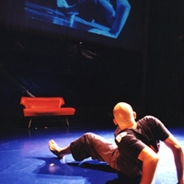Live*: playful without the preachy

What makes a show like *live** work is the fact that it not only plays with our perceptions of reality and illusion, but that it plays with the very idea of performance itself, stretching the concept of performativity to the far end of the spectrum and asking questions about who is audience and who is performer, and what constitutes spectacle in the first place. The great thing about this show, however, is that it asks all these questions without slacking off into the mentality that if one is asking questions, then anything goes in the way of aesthetics. All of the ideas that *live** tosses about are developed in a way that is fresh and exhilarating but also witty and smart.
The show, which was created by Norwegian company, Wee, under the direction of Italian choreographer, Francesco Scavetta opened in a kind of medias res state of the surreal with just a bit of artistic chaos thrown in. On stage a man plays a bass clarinet with a whole lot of reverb, behind him is an orange couch that is next to, of course, an enormous inflatable dinosaur that is, in fact, inflating while we watch. Behind all of this is a screen onto which the frontal view of the dinosaur is being projected. If Salvador Dalì were alive today, I think he would have appreciated the odd blend of familiar and disorienting inherent to this scene.
So where do you go once you’ve inflated the dinosaur and put down the clarinet? The show was more of a video exploration than a choreography, and so the camera that sat on the stage and projected real time images onto the screen at the back of the stage was central to the questions of perception that are being examined. I hardly think I could do a sufficient job of describing what I saw as it was so fluid, so constantly in flux, that just as my eye and my mind absorbed one idea or image, it was subverted or re-shaped in ever more surprising ways.
At times the camera is pointed at the audience, making us self-conscious of our role as spectator and actually turning us into the spectacle. The first instance of this happens near the beginning. For some minutes the camera roams the audience as though looking for someone until it lands on a man who, as the camera focuses on him, insolently lights up a cigarette. This man turns out to be Scavetti, who then gets up and makes his way to the stage. This playfulness set the tone for the rest of the piece.
Perhaps even more interesting were the times when the projections on the screen manipulated both time and place by presenting a live image, of, say Scavetti, the solo performer, on stage and then layering that image with a previously shot image of something that wasn’t currently on stage. A notable example of this was when a projection of an audience member was shown sitting beside Scavetti on the couch, that he was in fact sitting on during the show, but in the projection he was doing something that he wasn’t doing in real time, causing me to wonder the extent to which *live* really was live. Perhaps my favourite reality-bending moment happened during the rolling of the credits on the screen. In real time Scavetti leaves the stage and walks out of the theatre, while on the screen, we witness him making his way up the stairs of the Dance Centre, out the front door and onto Davie Street, interacting with the people around him, eventually making his way into a bar and having a drink as his name and the name of his collaborators appear on the screen alongside the ongoing image of Scavetti post-show. Of course, Scavetti makes his way back to the theatre in time for curtain call. Sequences such as this one continually caused me to absorb the possibility that reality itself is not contained in a rigid structure, but occupies a spectrum at the far ends of which time and space are elongated and twisted to present an image that contains strains of familiar reality, but it is distorted so that I wonder if I can trust my perceptions of the most basic things.
What *live** did so well was to create a mood that was playful, inventive and even somewhat intellectual without being pretentious or preachy. The show stayed firmly in the realm of lightheartedness, and still managed to ask some very germane questions about the nature of art, reality and the interaction of these two, but it did so without forcing a particular agenda or obviously espousing a certain conclusion. There were some truly lovely moments that I felt could have been pushed further than they were, but I am loathe to begrudge these artists their right to keep their show in the realm of mirth, as it was this sense of fun that actually let my imagination take flight as I witnessed this very smart evocation of the surreal develop.
_live* Concept/choreography/dancer: Francesco Scavetta; Music/live electronics: Luigi Ceccarelli; Musician: Paolo Ravaglia (clarinets); Sound engineer: Antonino Chiaramonte; Video: Tone Myskja, Francesco Scavetta; Live video mixing: Tone Myskja/Giampaolo Rampini; Light design: Ruth-Marie Bottheim/Stefano Stacchini; Objects: Johannes Dimpflmeier; Production leader: Gry Kipperberg; it was held at the Scotiabank Dance Centre May 7 -9_



